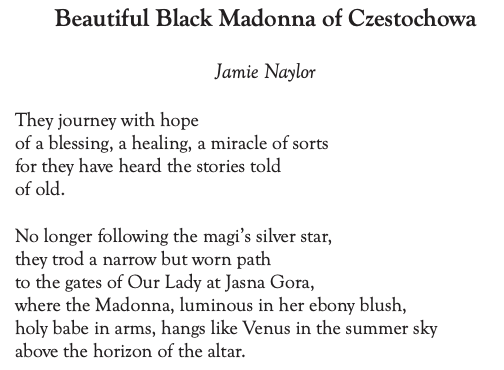Articles/Essays – Volume 41, No. 1
Beautiful Black Madonna of Czestochowa
They journey with hope
of a blessing, a healing, a miracle of sorts
for they have heard the stories told
of old.
No longer following the magi’s silver star,
they trod a narrow but worn path
to the gates of Our Lady at Jasna Gora,
where the Madonna, luminous in her ebony blush,
holy babe in arms, hangs like Venus in the summer sky
above the horizon of the altar.
For centuries she watched like a gentle cloud
over the sorrowful people of the Polish lands
whose faith lifted in the little cathedral like gauzy curls of smoke
rising from tapers in prayerful hands,
burnishing mother and child in a rich sable patina,
the color of autumn’s last leaves—
their halos still glistening gold.
As we enter, the sanctuary sparkles
with candles, like a sea of stars on a moonless night,
held by the faithful spilling from the filled pews, singing praises
in many languages with
one voice, one sight.
Just a tourist, I suddenly feel like a dilettante as I see the devotion
and expectation, like children on Christmas morning, in their eyes.
The emerging intensity startles my daughter Emilee, still young—
she has never seen such need,
such pleading, such pain,
such adoration.
It is said that Mary and Jesus were painted by Saint Luke himself,
only a season after the child become man hung on the cross,
as he sat at the bench of cedar wood
carved by the carpenter’s hand.
And while he painted the woman in life, they say
she spoke a wonderful tale, of a birth in a stable,
of hosts of angels, of wise men, of shepherds,
of Gabriel.
“Alleluia, alleluia, to the Mother and her Lamb,”
“Czerna Madonna,” “Schwarze Madonna,” “Beautiful Black Madonna.”
The song ascends with fervor beyond the rafters
in the graceful wooden chapel
and we also are carried up with the wonder of Mother and Child.
Only then do we notice the mountain of crutches discarded in the corner.


 Back to full Issue
Back to full Issue

